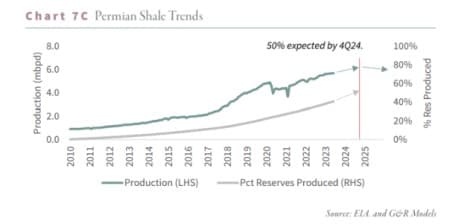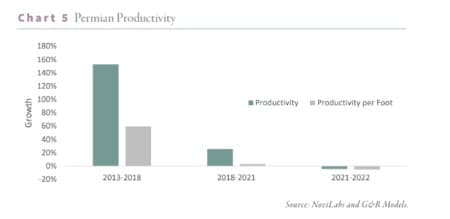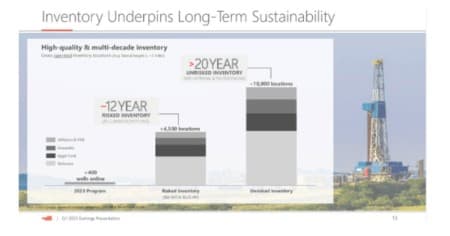In this article, I will update the general trends now being observed with daily production out of the Permian basin. In past articles, I’ve discussed the fact that it was clear that the quality of Permian acreage remaining to drill was on the decline. As this basin is the only major oil producer continuing to add barrels of daily output, this has broad implications for supply and prices. In the June 2023 edition of the EIA-914, the monthly forecast on oil and gas output, the Permian is shown with a slight decline for the July/August time period. This is the first time since Feb of 2021 this has occurred during the Snowmageddon of 2021.
Whatever you think about the longevity of this basin, one thing is absolutely undeniable. We are currently extracting nearly 2 bn BOE annually from it. Over the last five years we've withdrawn more than 6 bn BOE. Since we began fracking about 15 years ago, we've pumped out ~14 bn BOE. We’ve been climbing the hill in Hubbert’s Peak, and soon the descent will begin.
We will also discuss one way to play the information I will present here. In the coming quarters, we believe there will be an increasingly sharp demarcation between winners and losers. Already there are companies exhibiting signs of landing in the former category. Please read on for a top pick in the shale category.
Hubbert’s Peak in the Permian
Natural Resources analyst firm, Goerhring & Rosenscwajg-G&R, has modeled production trends that suggest that "Hubbert's Peak" for the Permian will hit late next year. Hubbert was a geologist who theorized that once half a basin's reserves had been recovered, it would have essentially “peaked.” The graph below, taken from a G&R report highlights their expectations. G&R could be of some, but the point remains, there is an inflection point coming that will tilt the slope downward. The firm estimates using their models that about 20 bn barrels of commercially recoverable oil remain in the basin. At current production rates, that’s about 11 years of output.

That’s a good bit less than some other estimates, including the one put out by the Enervus, an energy analyst firm, which uses data from the U.S. Geophysical Survey-USGS, projects another 50 bn barrels could be produced. Time will tell as to what the final tallies will be, but the data coming in now supports G&R’s analysis regarding a midpoint that will come late next year.
Acreage quality
One indicator is that much of the best acreage has been drilled. This is a point I've made many times in past articles. During the low-price era from 2017-2020, many companies pulled forward their Tier I- "geological parameters such as thickness, thermal maturity, organic content, oil in place, porosity, and permeability to make accurate well-quality predictions," acreage for it to meet investment thresholds and payout requirements. When prices are low, you develop your best assets.
In their report G&R put their finger on this aspect of the aging of Permian potential.
“We turned to advanced methods, including machine learning and neural networks, and achieved surprising results. Instead of improved drilling techniques, we concluded that two-thirds of the improved productivity between 2013-2018 came from favoring the best drilling locations. In 2013, 22% of Midland wells were Tier 1. By 2018, Tier 1 represented 50% of all wells. Since a Tier 1 well is nearly twice as productive as a Tier 2 well, the migration from lower to higher quality areas drove a massive amount of the improved well productivity.”
Technology impact
In a recent Special Report for OilPrice, The Future of Oil and Gas, we discussed how technology was extending the economics and productivity of new wells in shale reservoirs. By virtue of longer horizontal intervals, increased completion intensity, and a better understanding of optimal spacing to minimize interface between wells among other things, the output from shale reservoirs has been increased. But, there is no free lunch, and technology proves to have limits in its ability to generate increasing amounts of oil and gas per foot of interval.
The graph below from the G&R report we’ve been discussing highlights this decline in productivity. Productivity per foot of interval is dropping.

Parent well, child-well relationships are in play here. As G&R notes in their commentary, “Child” wells-which are wells subsequent to and often “side-tracked” from an original borehole, are not as prolific typically as the “Parent,” well.
“In the early days of shale development, producers would often drill a single horizontal well to test different parts of the basin and satisfy lease obligations that often require drilling a well within an allotted period. Later, the developer returns to the best areas and drills several more wells from a single pad to develop the resource economically. Producers now realize that the so-called “child” wells produce between 5 and 20% less oil than expected. In 2012 we estimate that only 30% of wells drilled in the three significant shale basins were “children.” By 2022, that figure had reached 85%. In Tier 1 areas, effectively, all current wells are children, with lower-than-expected productivity.”
In short, as parent wells water out and are plugged, there will be a more rapid decline than we have seen thus far as the active well count consists more and more of child wells.
Your takeaway
What all of this means when considering investing in a shale producer, the quality of the rock, and the blockiness of their surface acreage, which drives inventory, are two key features that will form our long-term investing thesis. I have always maintained that Devon Energy, (NYSE:DVN) would be in the top tier of shale producers for these reasons. Clay Gaspar, President of Devon comments on their latest 6-well pad development in Lea County, New Mexico-
“Individual wells at Exotic Cat flowed at rates over 7,200 BOE per day and well -- per well recoveries from this pad are on track to exceed two million barrels of oil equivalent. The flow rate from this activity rank among the very best projects Devon has ever brought online in the basin.”
Using simple math, with six wells online producing 7,200 BOEPD, Exotic Cat Raider should return its ~$60-70 mm capital cost in about 2-3 months. In this scenario, at the 2-month period, approximately 2.59 mm BOE have been produced, leaving another 9.41 mm BOE to be produced. Natural declines will impact this calculation in reality, extending the payout time somewhat, but the simple math looks pretty good. No wonder Mr. Gaspar was so enthusiastic.

The next metric we need to review is inventory depth. At their current rate of development, ~250 Delaware wells per year, there remains a 12-year Risked inventory. As drilling continues and more is learned from the data collected, additional “DeRisking” will add another couple of thousand Top-Tier drilling locations to the total and extend the asset life to ~20 years.

Finally, Devon has proven to be a shrewd inventory consolidator with its acquisition of WPX Energy in 2021. It has also made major inventory additions in other basins. Notably Validus Energy in the Eagle Ford basin in 2022, and RimRock in the Williston basin.
G&R closes out their commentary on shale thusly-
“Based on current drilling activity, the average publicly traded Permian company will run out of Tier 1 drilling locations within 3.7 years. We firmly believe that as the market realizes how little Tier 1 acreage remains, those with the best inventory will be treated as valuable assets. If we are correct, the age of shale growth is now behind us, and the reality of Hubbert’s Peak is at hand. The immense growth of the shales over the past decade has blinded many analysts to the declining trends in global conventional production. That luxury is about to end.”
With all of that in mind, we believe that Devon Energy, trading at <5X EV/EBITDA and $59K per flowing barrel, is substantially undervalued by the market. We also think a near-term trading opportunity will emerge when the company reports on August 2nd, 2023. There is a good chance if Q-2 earnings are missed by the Super Majors, ExxonMobil, (NYSE: XOM), and Chevron, (NYSE: CVX) are any guide, there will be a short-term down draft in shares of DVN. We view this as a buying opportunity below $50 per share.
By David Messler for Oilprice.com
More Top Reads From Oilprice.com:
- UK Windfall Tax Here to Stay Despite Energy Sector Overhaul
- The Dark Fleet: How Unknown Traders Keep Russian Oil Flowing
- Big Oil Continues To Be Pushed Toward Greener Endeavors



















The fact remains oil majors are their own worst enemy feasting on Government corruption(s) rather than doing their job.
By way of specific example Tesla has created an upgrade cycle for onshore oil drilling which is far more workable to tie into existing and extant USA energy infrastructure than offshore energy is.
Since California refuses to allow more offshore oil drilling nor does Northwest Mexico/Baja..
Their is plenty of oil it's in Greenland and Alaska but hard to get to because of permafrost same with Siberia. The South China Sea as well has plenty of oil KBR started the Vietnam War just to try to get it.
Yes Florida and California want their beaches to stay nice and pretty I lived in Louisiana BP destroyed our Seafood industry it took 10 years for the fish to come back. We had to import 90% from China for a while just because of one oil spill.
The industry will figure it out they always do.